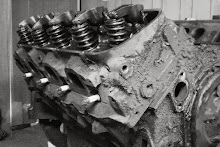Older engines, especially larger older engines, are sometimes referred to as, "fix-it-with-a-hammer simple," or "fix-it-with-a-file simple," or various variations on this theme. The idea is that they were made to be so robust, and with such loose tolerances, that no particular precision is required when working on them. It is often said with admiration and nostalgia for the "good old days," but can also be used with snide derision. The latter typically comes from someone who is either trying to sell you a newer engine, or someone who has just purchased a newer engine.
I would not classify my 1972 LS3 as either "fix-it-with-a-hammer," or "fix-it-with-a-file," but that doesn't mean that nothing ever gets hammered or filed in the process of working on it.
One thing that required filing was the piston rings. Piston ring end gap is the size of the gap between the ends of the piston ring when it is installed in the cylinder bore. On a stock engine, this is set per the manufacturer's specifications, and when stock piston rings are ordered, they almost always come with the correct end gap. Performance engine builders, however, may want to set their piston ring end gap at some size other than what the manufacturer recommends. For that reason, aftermarket piston rings can be purchased with zero end gap, and then filed to give whatever end gap specification the engine builder wishes to use.
I accidentally ordered piston rings that were not gapped, and would require filing. Here is a picture showing that the ends of the piston ring butt up to each other in the cylinder bore.
The ring is actually made to have a negative gap, i.e., the ends want to overlap each other. You would never want to assemble an engine that way, but I guess it allows the engine builder set any gap he wants to. I suppose it might even also allow the engine builder to run the ring in a larger cylinder bore, if he wanted to reduce ring tension or something like that.
So, I accidentally ordered these rings, and then I found out that since I'm not using stock pistons, the piston manufacturer recommends a different end gap than the stock specification, anyway. Their piston runs the top ring closer to the piston crown than a stock piston, so the ring tends to get hotter, which means it will expand more, which means it has to have a larger end gap or else the ends will butt up against each other and start to buckle the ring.
So, I ordered a ring end gap filing tool online. There are much nicer versions of this tool, which are also much more expensive, but I figured I could get by with a little hand-cranked version. I unbolted the bench vise and swivelled it out of the way, and used one of its bolt holes in the bench to hold the end gap filer down:
Coincidentally, I mentioned this project to a guy I work with, who used to work for Ford in their NASCAR program. He said that Ford told the NASCAR engine builders to just let them (Ford) know what size ring end gaps they (the engine builders) wanted, and Ford would supply the rings. He said that Ford just didn't think the race teams were careful enough when they filed their rings, and so Ford preferred for them not to do it. So ... that was a little daunting, considering that professional engine builders supposedly can't do this job reliably, but I decided to just take it as good advice to be extra careful. Anyway, I'd already ordered the end gap filer.
Here is a photo of a ring on the end gap filer, ready for filing:
The tool is very simple in concept, but the key feature is the two little pins sticking up on either side of the grinding wheel. In theory, you could use a hand file to file piston ring end gaps, but the danger there is that you have to be really careful to make sure that the ring ends stay parallel to each other (and perpendicular to the cylinder wall). I didn't trust myself to do that sixteen times (two rings per cylinder), so I bought the end gap filer. The vertical pins are positioned so that when you place a ring on the filer and push it up against the pins, it will keep the end that you are filing parallel to the grinding wheel, which will ensure that it will be parallel to the other ring end when you are done.
They say that you should always turn the hand crank towards yourself as you are filing. I assume this is so that any burrs that don't get removed will be pointing away from the cylinder wall when the ring is installed.
So, you put a ring on the filer, turn the crank some, file a little material off, and then you have to check your progress. To check the end gap, you install the ring in a cylinder and then measure the gap with a set of feeler gauges. To install the ring, you just put it in the cylinder, and then use a piston to push it down into the bore. The purpose of using the piston (upside down, with its crown touching the ring) is to keep the ring square in the bore. If the ring isn't square, you won't get a good measurement.
I read some texts that said you should measure the end gap at the bottom of the piston's travel, and others that said you should measure it at the top of the piston's travel, but either way, they're basically saying to measure it close to where ring reversal will occur. I did it at the top, because that way you can use the ring grooves on the piston to see where ring reversal will be. In other words, if you have the piston upside down with its crown on the ring, and the corresponding ring groove is at the deck of the cylinder block, then that should put the ring in the area where ring reversal will occur.
(Regarding the photo above: sometimes when you don't know what you're doing, you might wear a shirt that makes it look like you do. Sometimes that shirt might have a nametag on it. Sometimes that name might not be yours. Sometimes that name might be "Kaiser.")
After the ring is in the bore, you can remove the piston and measure the end gap using a set of feeler gauges. This photo shows a properly (I hope) gapped top ring in the bore:
For the ring set that I got, the top rings are a much harder material than the second rings. I had to file a ring for more than five minutes continuously to even start to get close to the proper end gap. When I did the second rings, I actually took off too much material from several of them because I didn't realize that they were a much softer material, and even after I knew that they were, I had trouble adjusting to how much easier it was to file them. I ordered some more second rings to start over and get it right.
After the rings were filed, that meant I could finally start assembling the engine's bottom end. First, I built up eight rod-and-piston assemblies, and installed the rings on the pistons. The piston manufacturer said to use an engine assembly lube on the piston wrist pins, but not grease. The engine assembly lube I'd been planning to use was Lubriplate, but the Lubriplate tube said "grease" on it, so I decided not to use it on the wrist pins. Instead I used a Lucas Oil engine assembly lube, which is a green oil that is thicker and stickier than engine oil. I figured it seemed like it fit the bill for what the piston manufacturer wanted, and it also has a nice minty smell to it (no, really!). After building up the rod-and-piston assemblies, I was finally ready to start putting pistons in the block.
When I worked in my first job after college, I got to go to Switzerland to get trained in how to work on a 20L V8 diesel that our company made. Their process for lubricating the piston and rings before installing them in the engine was just to dunk the whole piston in a tub of oil. I thought that seemed like a smart and effective method, so I cut the top off of an empty five-quart oil jug, and poured in one quart of my camshaft break-in oil. That gave me a convenient source of break-in oil for dunking pistons, as well as for lubricating cylinder walls, and anything else that needed oil.
It's messy, but it's effective. I put a large zip-lock bag over it to keep it clean when I'm not using it.
So, one at a time, I dunked a piston, put it in the piston ring compressor, lowered the dangling connecting rod down into the appropriate cylinder, and tapped the piston down into the cylinder.
Then I seated the rod on its journal on the crankshaft, and torqued the rod cap.
Eight happily torqued rod caps:
A left bank's worth of happy pistons:
And if you can't tell that those pistons are happy ... well, I just can't help you with that.




















